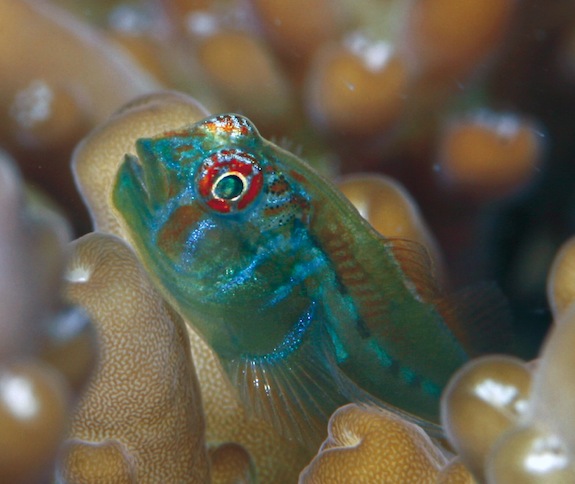When Attacked, Corals Send Out Chemical Signals to Recruit Bodyguard Fish
New science reveals that, when threatened by toxic seaweed, corals send out chemical signals to small goby fish that remove the coral-choking greenery
![]()

New research reveals that corals send out chemical signals to recruit the help of Goby fish in removing toxic seaweed. Image courtesy of Danielle Dixson
Corals are constantly under attack. Sea stars and other predators would love to take a bite, coral diseases lie waiting to take them out and many human-caused stresses persist in the water they inhabit, such as pollution, warming temperatures and rising acidity.
One of the first signs of a sick reef is the takeover of seaweeds, which continually threaten even healthy corals. However, corals aren’t alone in the fight against greenery, according to new research published in Science. When attacked, some corals send out chemical signals to their bodyguards—small goby fish—who scrape off or eat the coral-choking seaweeds.
Turtle weed (Chlorodesmis fastigiata) threatens corals because, upon contact, it releases a noxious chemical that disrupts their food source, the photosynthetic algae (zooxanthellae) that live inside their cells, ultimately leading to coral bleaching. Although most fish don’t have a palate for such toxic seaweed, authors Mark Hay and Danielle Dixson from the Georgia Institute of Technology observed coral gobies—small fish that spend their lives living in a single coral colony—eating it, and they wondered if there was more to this behavior than taste.
Hay and Dixson placed turtle weed on small staghorn coral (Acropora nasuta), a common reef-building coral found in the Pacific and Indian oceans, while in the presence of two goby species. The gobies cleaned up quickly: Within three days, 30% of the turtle weed was gone, and coral bleaching dropped by 70-80% compared to a goby-less seaweed invasion.

Without the protection of goby fish, corals are much more likely to become overgrown with seaweed. Image via Ocean Portal/Wolcott Henry
“These little fish would come out and mow the seaweed off so it didn’t touch the coral,” said Hay in a press release. “This takes place very rapidly, which means it must be very important to both the coral and the fish.”
In a series of experiments, the researchers worked out how the coral contacts the gobies to let them know that they need their hedges trimmed. Once the coral gets hit with chemicals from the invading turtle weed, it releases its own chemical signal—an emergency call to gobies—within 15 minutes. And, within another 15 minutes or less, gobies receive the message and swoop in to nibble away at the encroaching foliage.
What are the gobies getting out of this arrangement? The broad-barred goby (Gobiodon histrio) got a boost in its own defenses. It produces its own poisonous mucus to deter predators and, after eating the noxious turtle weed, this mucus impaired their predators’ swimming ability more than twice as fast, the researchers found. But the other goby species—the redhead goby (Paragobiodon echinocephalus)—doesn’t eat the seaweed, simply shearing it off the coral. What is its benefit?
“The fish are getting protection in a safe place to live and food from the coral,” Hay said. “The coral gets a bodyguard in exchange for a small amount of food. It’s kind of like paying taxes in exchange for police protection.”

Goby fish spend their entire lifetimes with the same coral. Image courtesy of Georgia Tech/Joao Paulo Krajewski
This kind of chemical signaling system is the first observed in coral reef organisms—but it surely isn’t the only one. Many coral reef organisms are interdependent, relying on one or two other species for food or habitat, which means that the loss of just a few species can accelerate the disappearance of many others. For example, if these coral-cleaning gobies were overfished, say for the aquarium trade, the reef would be threatened by seaweed takeover, which could then degrade the entire community.
“Who would have thought that such a small, seemingly insignificant fish might play such a large role in keeping corals from being killed by seaweeds?” said coral reef biologist Nancy Knowlton from the Smithsonian National Museum of Natural History, who did not participate in the research. “It’s a compelling example of why maintaining biodiversity is so important.”
It’s also possible that such subtle chemical signals could be disrupted by ocean acidification. Clownfish and damselfish raised in seawater with the acidity scientists predict we’ll see in the year 2050 have trouble identifying scents in seawater to find their homes or avoid predators. If these gobies have similar problems, the impacts of acidification on reef communities could be greater than expected.
 Learn more about coral reefs from the Smithsonian’s Ocean Portal.
Learn more about coral reefs from the Smithsonian’s Ocean Portal.